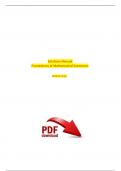Solutions Manual
Foundations of Mathematical Economics
Michael Carter
, ⃝ cQQQ2001Q MichaelQ Cart
SolutionsQ forQ FoundationsQ ofQ MathematicalQ Economi er AllQrightsQreserve
cs d
ChapterQ 1:Q SetsQ andQ Spaces
1.1
{Q1,Q3,Q5,Q7Q. . . Q}QorQ {Q�Q ∈ Q�Q :Q �Q isQ oddQ}
1.2 EveryQ � ∈ �Q alsoQ belongsQ toQ �.Q EveryQ �
∈
�Q alsoQ belongsQ toQ �.Q HenceQ �,Q�Q haveQpreciselyQ theQ sameQ elements.
1.3 ExamplesQ ofQ finiteQ setsQ are
∙ theQ lettersQ ofQ theQ alphabetQ {QA,Q B,Q C,Q . . . Q ,Q ZQ}
∙ theQ setQ ofQ consumersQ inQ anQ economy
∙ theQ setQ ofQ goodsQ inQ anQ economy
∙ theQ setQ ofQ playersQinQ aQ ga
me.QExamplesQ ofQ infiniteQ setsQ ar
e
∙ theQ realQ numbersQ ℜ
∙ theQ naturalQ numbersQ �
∙ theQ setQ ofQ allQ possibleQ colors
∙ theQ setQ ofQ possibleQ pricesQ ofQ copperQ onQ theQ worldQ market
∙ theQ setQ ofQ possibleQ temperaturesQ ofQ liquidQ water.
1.4Q �Q =Q {Q1,Q2,Q3,Q4,Q5,Q6Q},Q �Q =Q {Q2,Q4,Q6Q}.
1.5 TheQ playerQ setQ isQ �Q =Q {QJenny,QChrisQ} . QTheirQ actionQ spacesQ are
��Q =Q{QRock,QScissors,QPaperQ} �Q =Q Jenny,QChris
1.6 TheQ setQ ofQ playersQ isQ �Q ={Q 1,Q2 , . . ., Q}�Q . Q TheQ strategyQ spaceQ ofQ eachQ playerQ isQ t
heQ setQofQ feasibleQ outputs
��Q =Q {Q��Q ∈ Qℜ +Q :Q ��Q ≤ Q��Q}
whereQ ��QQisQQtheQ outputQ ofQ damQ �.
3
1.7 TheQ playerQ setQ isQ �Q =Q {1,Q2,Q3}. QThereQ areQ 2 Q =Q 8Q coalitions,Q namely
� (�Q)Q =Q {∅ ,Q{1},Q{2},Q{3},Q{1,Q2},Q{1,Q3},Q{2,Q3},Q{1,Q2,Q3}}
10
ThereQ areQ 2 Q coalitionsQ inQ aQ tenQ playerQ game.
1.8QQ AssumeQQthatQQ�QQ∈ Q(�Q ∪ Q�Q)� .QQQThatQQisQQ�QQ∈/QQ�Q ∪ Q�Q.QQQThisQQimpliesQQ�QQ∈/QQ�
� � � �
QQandQQ�QQ∈/QQ�Q,QorQ�Q∈ Q� QandQ �Q∈ Q�Q .Q Consequently,Q �Q∈ Q� Q∩ Q�Q .Q Conversely,Q assu
� � � �
meQ �Q∈ Q� Q∩Q�Q .QThisQQimpliesQQthatQQ�Q ∈ Q� QQandQQ�Q ∈ Q�Q .QQQConsequentlyQQ�Q∈/QQ�
QQandQQ�Q∈/QQ�QQ andQQtherefore
�∈/Q �Q ∪ Q�Q. QThisQ impliesQQthatQ �Q ∈ Q(�Q ∪ Q�Q)� . QTheQ otherQ identityQ isQ provedQ similarly.
1.9
∪
�Q =Q�
�∈�
∩
�Q =Q∅
�∈�
1
, ⃝ cQQQ2001Q MichaelQ Cart
SolutionsQ forQ FoundationsQ ofQ MathematicalQ Economi er AllQrightsQreserve
cs d
�2
1
�1
-1 0 1
-1
2 2
FigureQ 1.1:Q TheQ relationQ {Q(�,Q�)Q :Q � Q +Q � Q =Q 1Q}
1.10Q TheQ sampleQ spaceQ ofQ aQ singleQ coinQ tossQ {isQ�,Q�}Q .Q TheQ setQ ofQ possibleQ outcomes
Q inQthreeQ tossesQ isQ theQ product
{
{�,Q�Q} ×Q{�,Q�Q} ×Q{�,Q�Q}Q=Q (�,Q�,Q�),Q(�,Q�,Q�Q),Q(�,Q�Q,Q�),
}
(�,Q�Q,Q�Q),Q(�,Q�,Q�),Q(�,Q�,Q�Q),Q(�,Q�,Q�),Q(�,Q�,Q�Q)
AQ typicalQ outcomeQ isQ theQ sequenceQ (�,Q�,Q�Q)Q ofQ twoQ headsQ followedQ byQ aQ tail.
1.11
�Q ∩Qℜ+�Q =Q {0}
whereQ0Q =Q(0,Q0 , . . . Q,Q0)QisQtheQproductionQplanQusingQnoQinputsQandQproducingQnoQou
tputs.QToQ seeQ this,Q firstQ noteQ thatQ 0Q isQ aQ feasibleQ productionQ plan.Q Therefore,Q 0Q
∈ Q�Q.Q Also,
0Q ∈ Qℜ �+Q andQ thereforeQ 0Q ∈ Q�Q ∩Qℜ �Q+.
�
ToQshowQthatQthereQisQnoQotherQfeasibleQproductionQplanQinℜQQQQQ
+ Q,QweQassumeQtheQcont
�
rary.QThatQis,QweQassumeQthereQisQsomeQfeasibleQproductionQ∈plan Qℜ Q +
∖QQ{yQQQQQQQQQ
} QQQQQQ0Q
Q.QQThisQimpliesQtheQexistenceQofQaQplanQproducingQaQpositiveQoutputQwithQnoQinputs.
QThisQtechnologicalQinfeasible,Q soQ thatQ �Q∈/Q �Q.
1.12 1. QQLetQQxQ ∈ Q�Q(�). QQThisQQimpliesQQthatQQ(�,Q− x)Q ∈ Q�Q. QQLetQQx′Q ≥ Qx.QQ ThenQQ(�,Q− x′ )Q ≤
(�,Q− x)Q andQ freeQ disposabilityQ impliesQQthatQ (�,Q− x′ )Q ∈ Q�Q. QThereforeQ x′Q∈ Q�Q(�).
2.QQ AgainQQ assumeQQ xQQ ∈ Q �Q(�).QQQQThisQQ impliesQQ thatQQ (�,Q− x)QQ ∈ Q �Q.QQQQByQQ free
QQ disposal,Q(� ′ ,Q− x)Q ∈ Q�QQ forQ everyQ � ′Q≤ Q�,Q whichQ impliesQQthatQ xQ ∈ Q�Q(� ′ ).QQ�Q(�
′ )Q ⊇ Q�Q(�).
1.13 TheQ domainQ ofQ “<”Q isQ {1,Q2}Q=Q �Q andQ theQ rangeQ isQ {2,Q3}Q⫋Q �Q.
1.14 FigureQ1.1.
1.15 TheQ relationQ “isQ strictlyQ higherQ than”Q isQ transitive,Q antisymmetricQ andQ asymm
etric.QItQ isQ notQ complete,Q reflexiveQ orQ symmetric.
2
, ⃝ cQQQ2001Q MichaelQ Cart
SolutionsQ forQ FoundationsQ ofQ MathematicalQ Economi er AllQrightsQreserve
cs d
1.16 TheQ followingQ tableQ listsQ theirQ respectiveQ properties.
< ≤√QQ √=
reflexive ×QQ
transitive √ √QQ √
symmetric √QQ √
×QQ
√
asymmetric
anti-symmetric √QQ × QQ ×
√ √
√Q √Q
complete ×
NoteQ thatQ theQ propertiesQ ofQ symmetryQ andQ anti-symmetryQ areQ notQ mutuallyQ exclusive.
1.17 LetQ∼beQanQequivalenceQrelationQofQaQsetQ�∕QQ=∅ Q. Q ThatQis,QtheQrelation ∼ QisQreflexiv
e,QsymmetricQandQtransitive.QWeQfirstQshowQthatQevery ∈ Q�Q�QbelongsQtoQsomeQequiv
alenceQclass.Q LetQ �Q beQ anyQ elementQ inQ �
∼ Q andQ letQ (�)Q beQ theQ classQ ofQ elementsQ e
quivalentQ to
�,Q thatQ is
∼(�)Q ≡Q{Q�Q ∈ Q�Q :Q �Q ∼ Q�Q}
Since ∼ isQ reflexive,Q �∼ �QandQsoQ�∈ Q∼ (�).Q EveryQ �∈
�Q belongsQ toQ someQ equivalenceQclassQ andQ therefore
∪
�Q = ∼(�)
�∈�
Next,Q weQ showQ thatQ theQ equivalenceQ classesQ areQ eitherQ disjointQ orQ identical,QQth
atQ is
∼(�)Q ∕=Q ∼(�)Q ifQ andQ onlyQ ifQ f∼(�)Q∩Q∼ (�) Q=Q ∅ .
First,Q assumeQ ∼(�)Q∩Q∼ (�) Q=Q ∅ . QThenQ �Q ∈ Q∼(�)Q butQQ�∈
�/ ∼( ). QThereforeQ ∼(�)Q ∕=Q ∼(�).
Conversely,QQassumeQQ∼(�)Q ∩Q∼(�)QQ∕=QQ∅ QandQQletQQ�QQ∈ Q∼(�)Q ∩Q∼(�).QQQThenQQ�QQ∼ Q�QQan
dQQbyQsymmetryQ �Q ∼ Q�.QQQAlsoQ �Q ∼ Q�QandQsoQ byQ transitivityQ�Q ∼ Q�.QQQLetQ�Q beQ anyQ
elementQinQQ∼(�)QQsoQQthatQQ�QQ∼ Q�.QQQAgainQQbyQQtransitivityQQ�QQ∼ Q�QQandQQthereforeQQ
�QQ∈ Q∼(�).QQQHence
∼(�)Q ⊆ Q∼(�). QSimilarQQreasoningQ impliesQQthatQ ∼(�)Q ⊆ Q∼(�). QThereforeQ ∼(�) Q=Q ∼(�).
WeQ concludeQ thatQ theQ equivalenceQ classesQ partitionQ �.
1.18 TheQsetQofQproperQcoalitionsQisQ notQ aQpartitionQofQtheQ setQofQ players,QsinceQ any
Q playerQcanQ belongQ toQ moreQ thanQ oneQ coalition.QForQ example,Q playerQ 1Q belongsQ toQ
theQ coalitions
{1},Q {1,Q2}QandQ soQ on.
1.19
�Q ≻Q�Q =⇒ Q �Q ≿Q �Q andQ �Q ∕≿Q �
�Q ∼ Q�Q =⇒ Q �Q ≿Q �Q andQ �Q ≿Q�
TransitivityQ ofQ ≿QimpliesQ �Q≿Q� . QWeQ needQ toQ showQ thatQ �Q∕≿Q� . QAssumeQ otherwise,
Q thatQisQ assumeQ �Q ≿Q �Q ThisQ impliesQ �Q ∼Q�Q andQ byQ transitivityQ �Q ∼Q�.Q ButQ thisQ im
pliesQ that
�Q ≿Q�Q whichQ contradictsQ theQ assumptionQ thatQ �Q ≻Q� . Q ThereforeQ weQ concludeQ thatQ �Q ∕≿Q �
andQ thereforeQ �Q ≻Q� . QTheQ otherQ resultQ isQ provedQ inQ similarQ fashion.
1.20 asymmetricQ AssumeQ �Q ≻Q�.
Therefore
while
3




